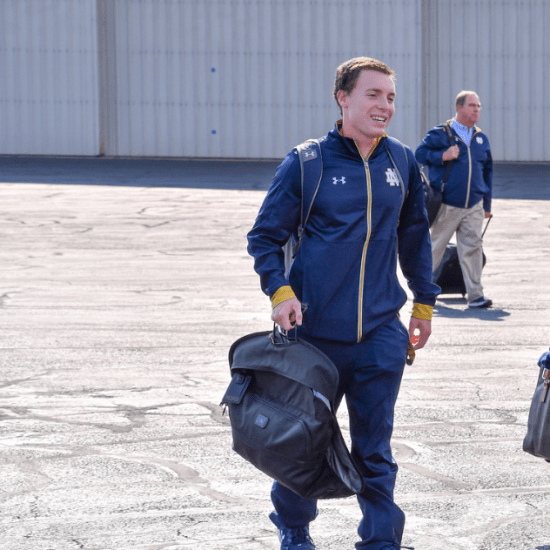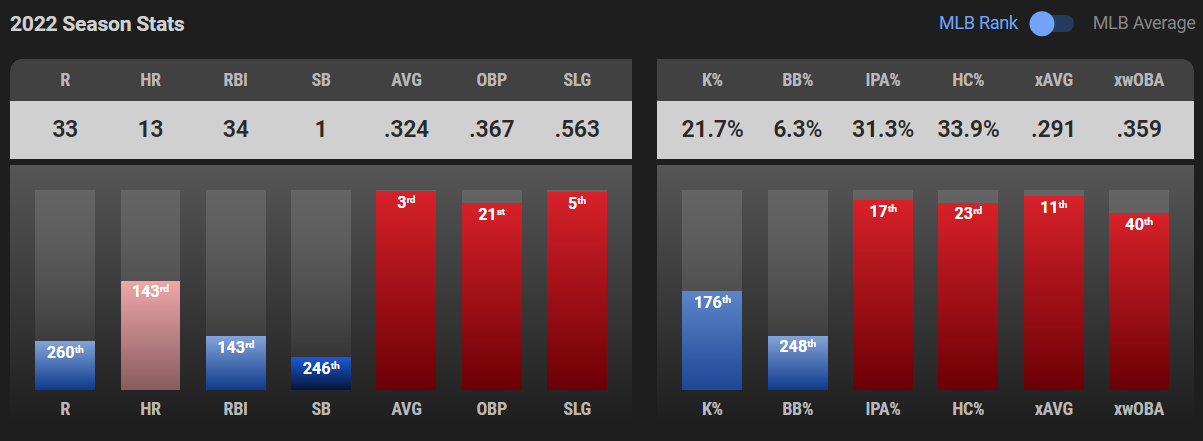For even the most ardent of fantasy baseball fans, it’s likely the Washington Nationals are an afterthought in your 2023 season prep. Their relative absence from the fantasy radar—even in a pool of the first 300+ players—is largely earned. The 2022 Nats finished the season with the worst record in baseball, the only team unable to eclipse 60 wins. Team record, however, is not why some 10-team leagues may not see a single Nat drafted. Washington has undergone a complete teardown of their once-vaunted core without acquiring any players who have proven to be immediate fantasy standouts.
But enough with the doom and gloom. Fantasy leagues are often won by finding players outside of the spotlight who are poised to take the next step. Better yet, the Nationals’ rebuild means there are at-bats aplenty in the District. In deep leagues, where successfully projecting playing time is a differentiator, there’s potential value in Washington. Let’s get to it. Here are your Sleepers and Busts for the Washington Nationals:
Sleepers
2022 stats (302 PA): .246 AVG, 33 R, 2 HR, 21 RBI, 7 SB
Amongst the collection of young hitters the Nationals acquired over the last two years, CJ Abrams joins Keibert Ruiz as the most MLB-ready. His speed on the basepaths and contact skills (with some potential for future power), gives the shortstop an early claim to the face of the rebuild in DC. The former sixth-overall pick sputtered in his rookie campaign. Abrams made the Padres out of Spring Training but struggled to find consistent playing time, hitting just .181 before being demoted back to Triple-A El Paso in early May. Abrams would return to the majors for San Diego but found relatively little success. Initial struggles and an overall disappointing batting line may stick out, but there are some positive signs.
Abrams hit .258 in 44 games upon joining the Nats, up from .232 with San Diego. More importantly, Abrams settled in as an everyday player for Washington, batting second in the final couple of weeks. The numbers aren’t jaw-dropping, but there were some small strides at the end of the season:
There’s a lot to unpack, but in summary, Abrams’ looked more like a fantasy-rosterable hitter in the final month of the season. First, Abrams was more aggressive on the bases. This is his surest path to fantasy value and should only increase with the new rules in place for 2023. In addition, Abrams was an asset in batting average. What changed? He hit far fewer fly balls, allowing him to take advantage of his speed. It’s clear the Nats’ coaching staff helped Abrams make the adjustments that should allow him to thrive.
In short, Abrams has the ingredients in place that make him worthy of a final-round dart throw in a 12-teamer. During the age of the three true outcomes, AVG and SB are the two toughest roto categories to come by. The Nats’ SS has the tools to provide both. Moreover, Abrams has a clear path to everyday playing time and is still growing into his skillset. If you’re lacking in speed or need a middle infielder, keep Abrams in mind this draft season.
2022 stats (70 IP): 4.50 ERA, 1.47 WHIP, 72 K, 4 W
Up next, we have another one of the players acquired in the Padres’ trade package for Juan Soto. In contrast to Abrams, MacKenzie Gore started the season much better than he ended it. Through the end of May, Gore posted a 1.71 ERA, 1.07 WHIP, and a 19.9 K-BB%. At the time, it all felt a bit like a mirage as he often relied exclusively on his fastball. With little sustained success of his secondaries, regression was all but assured. Few, however, suspected Gore to hit the wall that he did. After May, he pitched to an 8.68 ERA across 28 IP. His strikeouts declined while his walks skyrocketed, leading to a distressing 1.4% K-BB%. Evidenced by diminished fastball velocity, it was no surprise when Gore was shut down with left elbow inflammation.
While Gore didn’t make any appearances with the Nats, it is at least promising that the organization was convinced enough of his arm health to acquire him. The lefty is now fully healthy and is a lock for his new team’s rotation given the lack of other serviceable options. Gore is best viewed this draft season as a wait-and-see during Spring Training. If his upper-90s fastball velocity is back and there are signs of improved command, he’s worthy of late-round consideration in deeper leagues.
There have long been sky-high expectations for Gore since being selected as the third pick in the 2017 MLB Draft. Hopes of a fantasy ace don’t appear within range after multiple seasons of inconsistency and erratic command. It is possible, however, that Gore unlocks a new level with a change of scenery. The Nationals should not be confused as a pitching development factory, but the path to success might just be a small tweak or two away.
Gore makes for an intriguing pick at the end of your draft. In fact, he checks all the boxes of what you should be looking for as your draft concludes. Upside and a rotation spot? Check. A full arsenal of pitches with at least one plus offering? Check, the fastball is legit and there’s room for improvement with his slider and curve. Perhaps the best quality of taking a flier on Gore is how quickly we’ll know if this pick was a hit or miss. If Gore shows reduced velocity or continues to carry a bloated walk rate, he’ll be an easy decision to send back to the wire in favor of another potential breakout off to a hot start.
Busts
Given the aforementioned lack of fantasy buzz around the Nationals’ roster, it’s surprisingly difficult to identify players who truly qualify as bust candidates. Realistically, only two or three Nats will crack the top-250 picks. As a result, the following players won’t make or break your team. Consider these players with a degree of skepticism if they begin climbing up boards this preseason.
2022 stats (240 PA): .324 AVG, 33 R, 13 HR, 34 RBI, 1 SB
After over a decade of toiling in the minors, Joey Meneses was the sole bright spot during an otherwise bleak season in the nation’s capital. The 30-year-old rookie makes the shortlist of 2022 fantasy league winners, providing difference-making production across four categories upon making his debut on August 2nd. There will likely be two schools of thought around Meneses this spring: those who believe he’s a late bloomer and those who see a flash in the pan.
If early Steamer projections* are any indication, Meneses’s average draft position (ADP) could reach the heights of those with more established track records. In fact, the 1B/OF has one of the more notable projections in the entire player pool. Despite only 56 games in the bigs, Steamer pegs the longtime minor-leaguer for 29 HR, 91 RBI, and a .264 AVG*. It’s easy to see why. The career journeyman hits the ball hard, evidenced by a 33.9% hard contact rate with a 110.9 mph max exit velocity.
Despite the impressive debut, however, there’s reason to look elsewhere if Meneses’ draft stock finds helium. To begin, his 9.5° average launch angle suggests he does not lift the ball like a typical power hitter. While he consistently makes hard contact, it’s hard to believe heavily in the 29-HR Steamer projection, given there’s only a small list of true sluggers with a launch angle below 10 degrees.
In addition, Meneses’s .371 BABIP would’ve been tops in the league if qualified, a sign the rookie may have been the beneficiary of some batted ball luck. His average will likely come back down to earth over a full season as his BABIP normalizes and pitchers learn how to attack him at the plate. In particular, it wouldn’t be surprising if Meneses sees more breaking balls next year. He hit .338 on the pitch type last season, but a .236 xBA suggests it might be a way to neutralize him.
As evidenced above, there’s a ton of red on Meneses’ player page, but there are also a few red flags to consider. The Nat profile is eerily similar to an out-of-nowhere breakout from 2021: Frank Schwindel. Those who reached for the Cubs 1B in 2022 were sorely disappointed. There are occasional exceptions, but late career breakouts don’t often pan out.
*Steamer projections as of 11/19
2022 stats (148.2 IP): 5.02 ERA, 1.36 WHIP, 154 K, 7 W
Since Josiah Gray will go undrafted in standard 12-team leagues, it’s tough to label him as a bust. For those in 15-teamers, there may be a temptation to take a chance on Gray after pick 350 in the hopes we’ll start to deliver on the lofty expectations given his prospect pedigree. The 24-year-old may eventually prove why he was the centerpiece for Washington in the Max Scherzer/Trea Turner trade to the Dodgers, but there are too many question marks to make Gray anything more than a risky streamer.
Gray has shown promise with his slider (19% SwStr) and curveball (13% SwStr), but his fastball has been absolutely pummeled since entering the bigs. In 2022, the opponents teed off on the heater for a .304 AVG. Moreover, Gray’s fastball had a .738 SLG, the worst in the majors for any individual pitch with a minimum of 100 plate appearances. It’s clear the young pitcher will need to make an adjustment to his arsenal or usage to become a more effective starter.
Simply put, Gray gives up too many home runs and walks to be on your fantasy radar this draft season. In 219.1 career innings, Gray allowed 2.34 HR/9. For context, José Urquidy’s 1.59 HR/9 was the worst amongst qualified starters in 2022. Given his propensity for flyballs and the hitter-friendly nature of Nationals Park, Gray’s trouble with homers looks likely to persist. Perhaps just as concerning is the 10% BB rate early in his career. Dylan Cease was the only qualified starter in the league with a double-digit walk rate. It’s entirely too early to write off Gray as a future reliable major league starter. But with that being said, you should likely look elsewhere for a late-round pitcher in 2023.
Photos by Icon Sportswire | Adapted by Justin Redler (@reldernitsuj on Twitter)


